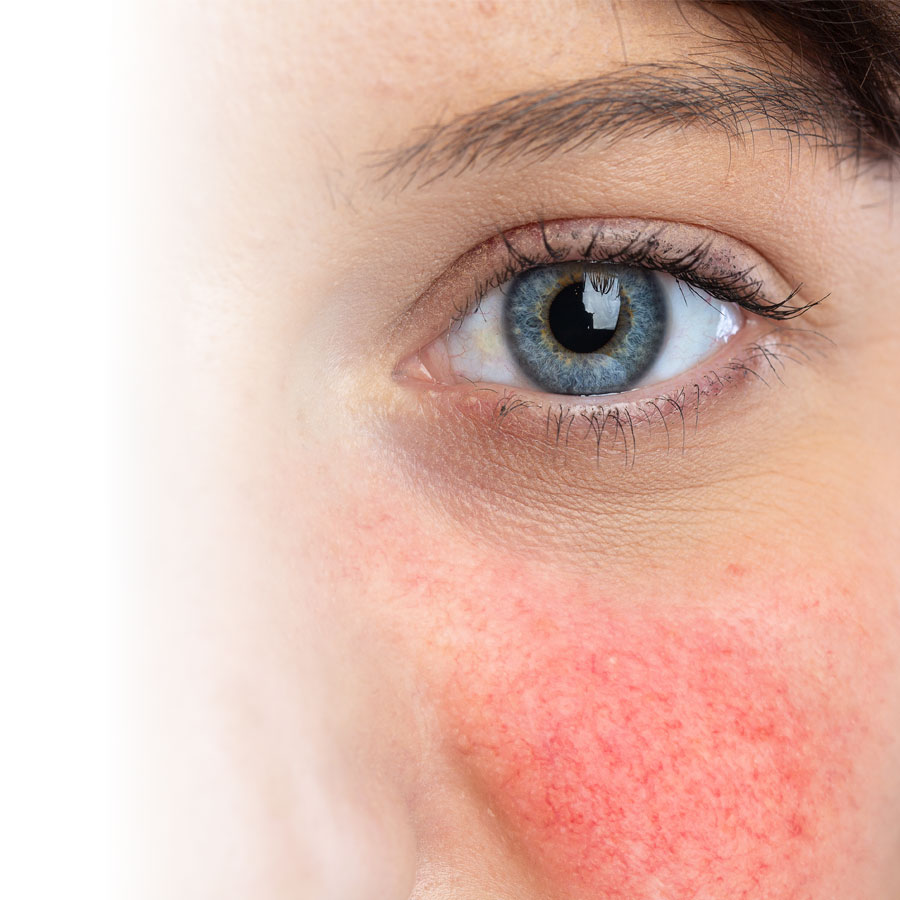Learn to detect the first symptoms of rosacea (i.e. redness, tingling, dilated blood vessels) in order to treat it more effectively.
What is rosacea or facial flushing?
Rosacea is a chronic and progressive skin condition that affects many individuals. From a medical perspective, it is not very serious. However, it can cause unpleasant sensations as well as a feeling of embarrassment, since it changes the appearance of the face. Without care or treatment, rosacea increasingly worsens and compromises well-being and quality of life.
Rosacea can affect individuals between the ages of 20 and 70, but a greater number of affected individuals have been observed between the ages of 30 and 50. People who have light-coloured skin or eyes or who tend to get flushed easily are predisposed to rosacea. Women are more often affected by it than men; the latter are more likely to have rhinophyma, which is characterized by significant swelling and redness of the nose. This manifestation is observed at an advanced stage of the condition.
What are the signs and symptoms of rosacea?
- The intermittent appearance of redness.
- If untreated, the redness persists, often resembling a sunburn that won't go away.
- Pimples begin to appear, sometimes in the form of facial papules (small, hard red bumps) or pustules. A burning or tingling sensation and the absence of blackheads differentiates them from acne.
- Small veins may dilate below the skin's surface and lose their elasticity over time. The redness then becomes diffuse and the lesions, permanent. The medical term used to describe this phenomenon is telangiectasia.
The term facial flushing is used to describe the presence of telangiectasia associated with rosacea.
Other secondary signs and symptoms can also be present:
- dry skin
- red plaques
- thickening of the skin
- irritated or itchy eyes
Individuals often do not seek timely medical attention, believing that it is just a skin complexion problem. Yet, appropriate care and early treatment can prevent the condition's progression and the onset of telangiectasia.
What are the factors that promote rosacea?
Certain factors promote the development of, worsen or exacerbate rosacea symptoms, such as the onset of redness. Here are some examples:
- smoking
- exposure to the sun
- heat
- the cold and wind
- hot drinks
- alcohol (especially red wine)
- spicy foods
- stress
- strong emotion
- certain drugs
How to prevent or slow down the progression of rosacea
Making certain lifestyle changes can help considerably. Here is some advice:
- Quit smoking. Your pharmacist's advice can help you during this process.
- Adopt a healthy lifestyle: eat well, practise moderate and regular exercise, and learn to manage stress.
- Avoid hot spices such as pepper, paprika, red chili pepper and cayenne pepper. Additionally, decrease the temperature of hot drinks.
- Consume alcohol with moderation.
- On hot and humid days, try to stay indoors, preferably where there is air-conditioning if possible. Avoid hot baths or showers, or saunas.
- If you take medication, ask your pharmacist if it can impact rosacea.
How to take care of skin affected by rosacea
Tailored daily care can help prevent and control rosacea.
- Wash your face with a product formulated for very sensitive skin, then rinse it with lukewarm water (never hot). Avoid any abrasive cleansers. Gently pat the face dry with a towel.
- After having cleaned the skin, apply a moisturizer once or twice a day. There are specially formulated products for very sensitive or rosacea-prone skin.
- Apply sunscreen with an SPF of at least 30 before each sun exposure. Daily use is often advisable.
- During winter, protect the face against the wind and cold with a scarf, for instance.
There are medical treatments available for rosacea, including topical and oral medications. Don't hesitate to speak to your pharmacist if you have questions about rosacea and its treatment.

